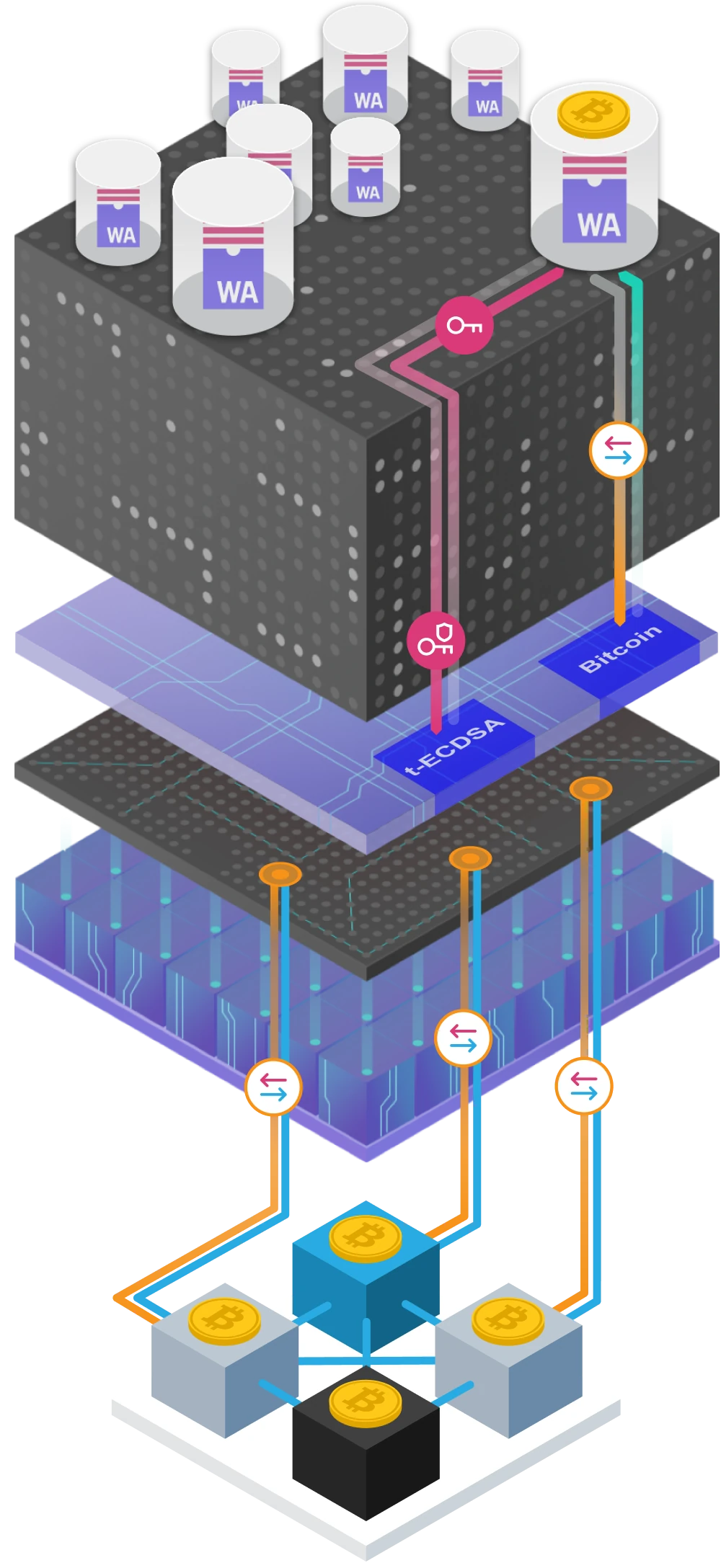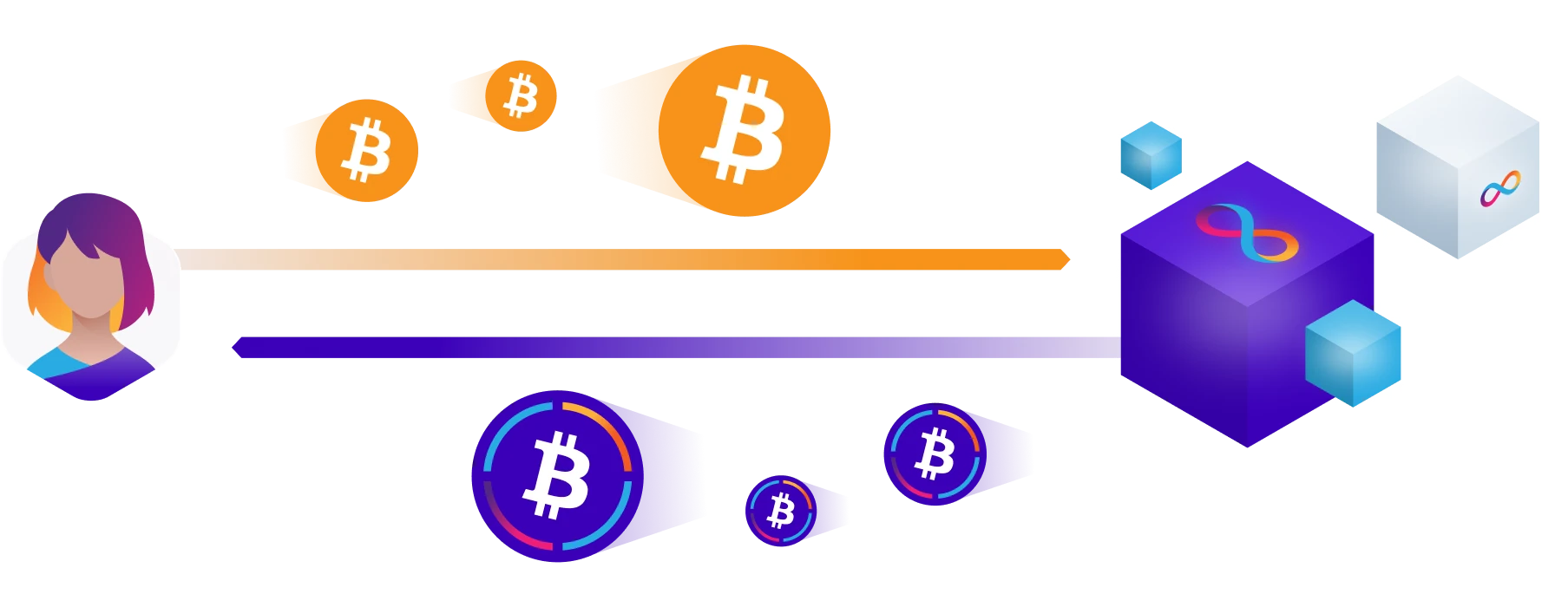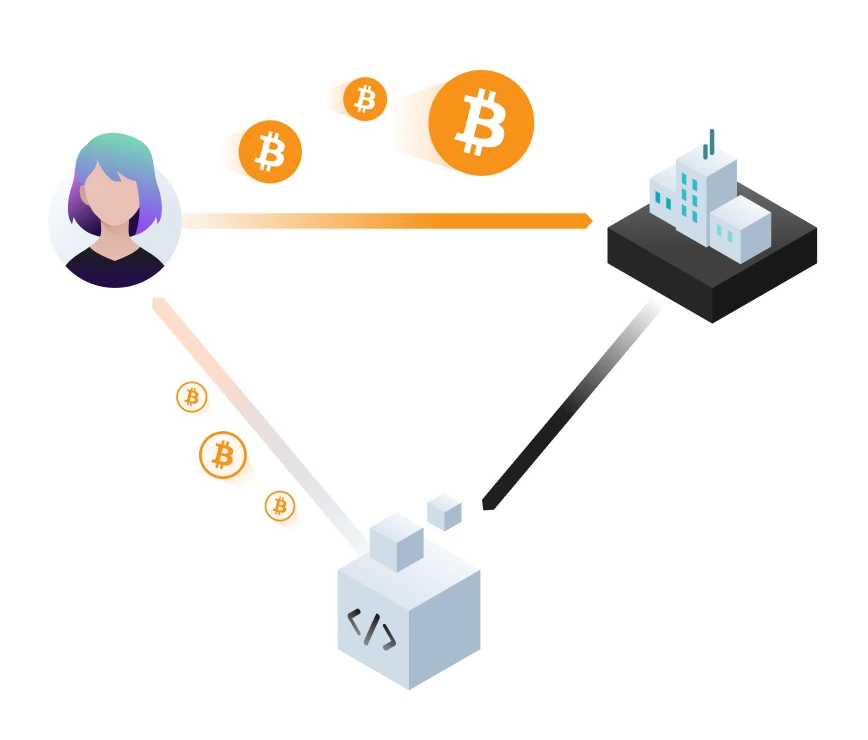Bitcoin on ICP
The Internet Computer (ICP) cryptographically integrates with the Bitcoin network, unleashing a plethora of opportunities to securely execute bitcoin transactions 100% on chain.

Think DEXs offering BTC trading pairs, decentralized fundraisers accepting Bitcoin, or Web3 SocialFi services allowing satoshis to be sent via chat messages!
Native Bitcoin
The Internet Computer (ICP) is integrated with the Bitcoin network at the protocol level. The canister smart contracts it hosts can create Bitcoin addresses as well as send and receive bitcoin directly on the Bitcoin network. This means bitcoin can be easily and securely incorporated into DeFi and Web3 services on the Internet Computer blockchain, without having to trust wrapped bitcoin from centralized bridging services, which are at high risk of being taken down or hacked, and can lead to billions of dollars in bitcoin losses.
The ICP x BTC integration comprises two key building blocks (and APIs): Network Integration & Chain-Key ECDSA
Combining these building blocks, ICP canisters can directly and securely hold, receive, and send bitcoin seamlessly as if the Internet Computer and the Bitcoin network were one blockchain. Another way of looking at it, is that the Bitcoin integration is the same as running a Bitcoin node on chain.
Network Integration
One key tech development allowing smart contracts on the Internet Computer to obtain the balances of Bitcoin addresses as well as directly send and receive bitcoin is inter-chain communication. As the ICP blockchain creates transactions for the Bitcoin blockchain, its nodes directly transmit the transaction to the Bitcoin network's nodes, without any need for intermediaries that might censor them. ICP nodes also directly pull blocks from the Bitcoin network to maintain Bitcoin's current UTXO set, allowing canisters to query the amount of digital currency, or balance, per Bitcoin address and its UTXOs. The functionality of sending Bitcoin transactions and querying balances and UTXO sets is accessed by canisters through the Bitcoin API.
Chain-Key ECDSA
The real magic behind Bitcoin integration is chain-key ECDSA signing — advanced threshold cryptography integrated with ICP. This is what enables ICP nodes to cooperatively create new Bitcoin addresses and sign Bitcoin transactions, using highly fault-tolerant, decentralized network protocols that are resilient to attacks by malicious nodes. The secret key is never stored in one place, instead it is broken down into key shares held by ICP nodes that are re-shared every 5-10 mins. When requested, nodes sign BTC transactions using the key shares without recreating the original secret key. Building on tECDSA, this protocol assumes a threshold of nodes to be honest. The process is called ckECDSA signing.
Chain-Key Bitcoin
Chain-Key Bitcoin (ckBTC) acts as a bitcoin ‘twin’ on ICP. It is issued and redeemed via canister smart contracts controlled by the NNS and cryptographically secured 1:1 with real bitcoin. It’s fast, low-tx-fee bitcoin on ICP with no intermediary.

In 2021, El Salvador became the first country in the world to use Bitcoin as legal tender. However, as bitcoin transactions are slow and have high fees, they are not practical for daily economic activities such as buying groceries or getting a coffee.
The Bitcoin network integration on the Internet Computer (ICP) is extremely powerful in terms of security and interoperability, but every bitcoin transaction still suffers the same low throughput, high latency, and high fees native to the Bitcoin network. Transaction fees alone can be higher than the cost of an espresso in El Salvador. Chain-key Bitcoin (ckBTC), a bitcoin ‘twin’ on ICP introduces layer 2 functionality fuelled by ICP properties like speed, scalability and low transaction fees to bitcoin. ckBTC makes using bitcoin practical for everyday transactions.
End-users can seemlessly transfer bitcoin any time between blockchains without any third-party bridges or custodians.
ckBTC is compliant with ICRC-1, the fungible token standard on ICP, and can be integrated easily by any service, e.g., wallets or DEXs.
What ckBTC is NOT

Not a Bridged Token
Most blockchains rely on so-called bridges to wrap and unwrap tokens, such as bitcoin. The recent incident where the FTX exchange acted as the custodian, and Sollet the bridge for wrapping and unwrapping BTC and ETH on Solana, demonstrated how bridges and intermediaries are highly vulnerable to hacks or other forms of compromise.
ckBTC is issued and redeemed via a canister smart contract — no bridge or custodian, and verifiable by anyone. The ckBTC canister is controlled by the NNS DAO, which means no single entity can initiate malicious activities without the approval of ICP governance token holders.
Not a Lightning Network
While a lightning network has many advantages, such as faster transactions and lower fees, transactions go through many channels that run on centralized cloud systems. ckBTC brings layer 2 functionality to the Bitcoin network — fast, low-fee payments — without the risk or limitations of a lightning network in that all transactions are held on the ckBTC ledger and never go through centralized channels.
True decentralized transactions on the Internet Computer are made possible via inter-chain communication with the Bitcoin network and chain-key ECDSA signatures.
Use your bitcoin
on ICP

ICDex
ICDex by ICLighthouse is the world's first 100% on-chain order-book-based decentralized exchange (DEX) running on the Internet Computer. Using ICP's native Bitcoin integration, you can already buy ICP using your BTC. ICDex also supports ICRC-1, which allows users to trade SNS tokens.

CrowdFund NFT
CrowdFund NFT is an alternative to Kickstarter and other traditional crowdfunding platforms. Running 100% on the Internet Computer, it uses NFTs to provide ‘proof of ownership’ in the projects you help crowdfund. Plus, you can now fund the projects you love in ICP and BTC.

VaultBet
VaultBet is a decentralized sports betting exchange that uses smart contract technology to make sports betting peer-to-peer, trustless and fun! Users are in control and markets decide the odds, not bookies. Connect your Plug wallet to trade bets in ICP and BTC.
Watch & Learn
From concept to coding — learn all about the Bitcoin Integration feature on ICP through these videos.
Explore more videosCode Bitcoin
Directly process bitcoin on the Bitcoin ledger using ICP smart contracts. Add bitcoin to your ICP Web3 services or create native Bitcoin DeFi.


